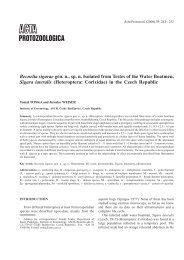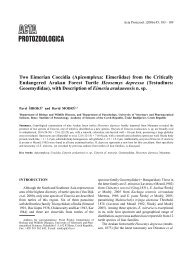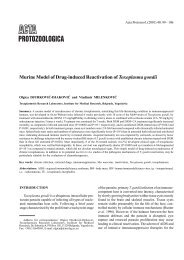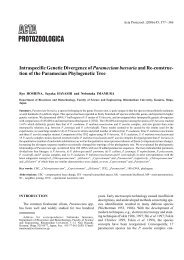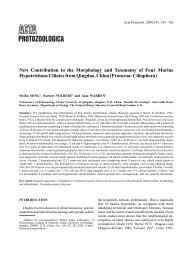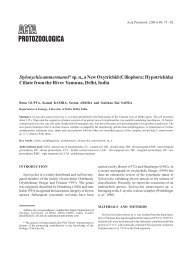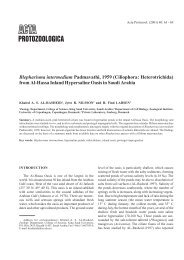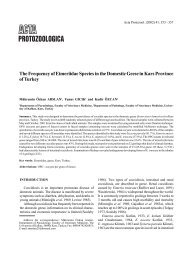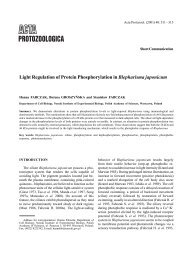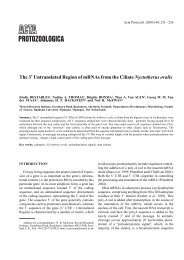Three New Species of Gregarines (Apicomplexa: Sporozoea ...
Three New Species of Gregarines (Apicomplexa: Sporozoea ...
Three New Species of Gregarines (Apicomplexa: Sporozoea ...
You also want an ePaper? Increase the reach of your titles
YUMPU automatically turns print PDFs into web optimized ePapers that Google loves.
Acta Protozool. (2001) 40: 303 - 309<br />
<strong>Three</strong> <strong>New</strong> <strong>Species</strong> <strong>of</strong> <strong>Gregarines</strong> (<strong>Apicomplexa</strong>: <strong>Sporozoea</strong>: Porosporidae)<br />
in the Estuarine Crabs from Kerala, India<br />
Puthampurayil K. PRASADAN 1 and Kuniyil P. JANARDANAN 2<br />
1<br />
Department <strong>of</strong> Zoology, Mary Matha Arts & Science College, Vemom (P.O.), Mananthavady; 2 Parasitology Laboratory,<br />
Department <strong>of</strong> Zoology, University <strong>of</strong> Calicut, Kerala, India<br />
Summary. Different development stages <strong>of</strong> 3 new species <strong>of</strong> cephaline gregarines, Nematopsis messor, N. quadratum and N. annulipes<br />
infecting the crabs, Metapograpsus messor (Forskäl), Sesarma quadratum (Fabricius) and Uca annulipes Edwards respectively are described<br />
and their systematic position discussed.<br />
Key words: crabs, gregarines, Metapograpsus messor, Nematopsis annulipes sp. n., N. quadratum sp. n., N. messor sp. n., Sesarma<br />
quadratum, Uca annulipes.<br />
Abbreviations: DW - deutomerite width, LA - length <strong>of</strong> association, PL - protomerite length, PW - protomerite width, TL - total length.<br />
INTRODUCTION<br />
All cephaline gregarines known to inhabit crabs are<br />
included in only 4 genera: Nematopsis Schneider, 1892;<br />
Cephaloidophora Mavrodiadi, 1908; Pachyporospora<br />
Théodoridès, 1961 and Stephanospora, Prema and<br />
Janardanan, 1989. Extensive survey <strong>of</strong> estuarine crabs<br />
in Kerala revealed the presence <strong>of</strong> 3 species <strong>of</strong> cephaline<br />
gregarines belonging to the genus Nematopsis. Detailed<br />
studies proved that they represent new species.<br />
The present paper provides their description.<br />
Address for correspondence: Puthampurayil K. Prasadan,<br />
Department <strong>of</strong> Zoology, Mary Matha Arts & Science College,<br />
Vemom (P.O.), Mananthavady-670645, Kerala, India; E-mail:<br />
drprasadan@yahoo.co.in<br />
MATERIALS AND METHODS<br />
The crabs, Metapograpsus messor (Forskäl), Sesarma quadratum<br />
(Fabricius) and Uca annulipes Edwards, collected from sandy and<br />
rocky shores <strong>of</strong> estuaries and river banks in Kerala, were examined for<br />
the presence <strong>of</strong> gregarine parasites. The carapace <strong>of</strong> each crab was<br />
removed, the alimentary tract was then transferred onto a slide and<br />
examined for gregarines. Trophozoites and sporadins were recovered<br />
from the midgut and gametocyts from the hindgut or from fecal<br />
matter. Gametocysts recovered at various stages <strong>of</strong> development<br />
were maintained in moist chamber for further development. The<br />
cysts completed development and extruded spores by simple rupture<br />
<strong>of</strong> the cyst wall in 24 h.<br />
Structural details <strong>of</strong> development stages were studied following<br />
the method reported by Prema and Janardanan (1989). Illustrations<br />
were made with the aid <strong>of</strong> a camera lucida; descriptions and measurements<br />
are based on a minimum <strong>of</strong> 20 live specimens. All measurements<br />
are in micrometers (µm); mean values are underlined.
304 P.K. Prasadan and K.P. Janardanan<br />
Types <strong>of</strong> all parasites (stained specimens on slides) and their host<br />
crabs are deposited in the parasite collections, Parasitology Laboratory,<br />
Department <strong>of</strong> Zoology, University <strong>of</strong> Calicut, Kerala (India).<br />
RESULTS<br />
Nematopsis messor sp. n. (Fig. 1, Table 1)<br />
Description<br />
Sporadins (Fig.1.1): biassociative; association<br />
caud<strong>of</strong>rontal; colour milky-white. Syzygy early, linear.<br />
Primites: protomerite shape hemispherical, wider than<br />
long, maximum width at posterior end; transparent lensshaped<br />
structure present at anterior end; epicyte uniformly<br />
thick, striated; endocyte granular. Septum circular,<br />
convex toward deutomerite; constriction at septum<br />
inconspicuous. Deutomerite ovoid, narrow behind septum,<br />
gradually widens caudally, posterior end broadly<br />
rounded; maximum width in posterior half; epicyte uniformly<br />
thick; endocyte granular. Nucleus spherical, faintly<br />
visible in fresh sporadins, variable in position; endosome<br />
single, spherical.<br />
Satellites: lengths on average slightly shorter than<br />
primites. Protomerite shape hemispherical, wider than<br />
long; epicyte uniformly thick, striated; endocyte granular<br />
with transparent lens-shaped structure at anterior end.<br />
Septum similar to primite (see above). Deutomerite<br />
ovoid, narrow behind septum, gradually widens caudally,<br />
posterior end broadly rounded; maximum width at posterior<br />
half. Nucleus and endosome similar to primite<br />
(see above).<br />
Gametocysts (Fig. 1.2): shape spherical; colour milkywhite.<br />
Cyst wall double; epicyst thick, hyaline, width<br />
uneven, 6.6-11.5; endocyst thin, width uniformly even,<br />
1.6.<br />
Gymnospores (Fig. 1.3): shape spherical; diameter<br />
4.5-5.3; uninucleated bodies arranged radially in rosette<br />
pattern around central, hyaline cytoplasm.<br />
Trophozoites (Figs 1.4-1.6): development extracellular.<br />
Smallest observed trophozoite (Fig. 1.4) has a hemispherical<br />
protomerite and ovoid deutomerite. In an association<br />
measuring 129.6 long (Fig. 1.6), the primite<br />
measured 70.7 by 37.1 and satellite 58.6 by 37.1.<br />
Taxonomic summary<br />
Type specimens: syntypes, No.Z/Par/G/101; deposited<br />
in the parasite collections, Parasitology Laboratory,<br />
Department <strong>of</strong> Zoology, University <strong>of</strong> Calicut, Kerala,<br />
India.<br />
Type host: Metapograpsus messor (Forskäl)<br />
(Arthropoda: Crustacea: Grapsidae). Symbiotype: host<br />
crab preserved in the Parasitology Laboratory (see<br />
address above). Additional hosts: None.<br />
Type locality: India, Kerala, Malppuram district,<br />
Kadalundi Estuary, sandy and rocky intertidal. Additional<br />
localities in India: Kannur district, Mavilayi and<br />
Muzhappilangad; Kozhikode district, Iringal and Kizhariyur<br />
(all sandy and rocky river banks).<br />
Collection dates: 1988 (February, March, November,<br />
December); 1989 (October through December); 1990<br />
(January through April).<br />
Site <strong>of</strong> infection: intestine.<br />
Prevalence: in 8 <strong>of</strong> 22 crab hosts examined.<br />
Etymology: named after the species <strong>of</strong> crab host.<br />
Remarks<br />
Nematopsis messor sp. n. resembles most to<br />
N. raoudi Vivárès, 1971 from the crab Portunus latipes.<br />
However, it differs in several significant ways, including<br />
the shape <strong>of</strong> primites and satellites; and in the presence<br />
<strong>of</strong> (1) a prominent lens-shaped structure at the anterior<br />
part <strong>of</strong> the protomerite, (2) a spherical nucleus and<br />
(3) a protomerite in the satellites. In addition, the species<br />
described above is from a different host and a different<br />
geographical locality. This is the first report <strong>of</strong> gregarines<br />
from Metapograpsus messor (Forskäl).<br />
Nematopsis quadratum sp. n. (Fig. 2, Table 1)<br />
Description<br />
Sporadins (Fig. 2.1): biassociative, association caud<strong>of</strong>rontal;<br />
colour milky-white. Syzygy early, linear.<br />
Primites: always larger than satellites. Protomerite<br />
shape hemispherical with a plano-convex to biconvex<br />
lens-shaped structure at anterior part; epicyte uniformly<br />
thick, striated; endocyte granular. Septum circular, convex<br />
toward deutomerite. Deutomerite elongate ovoid,<br />
narrow behind septum gradually widens caudally, posterior<br />
end broadly rounded; maximum width in posterior<br />
half; epicyte hyaline; endocyte granular; a transparent<br />
lens-shaped structure at posterior part. Interlocking<br />
mechanism between primite and satellite well developed.<br />
Nucleus spherical to ovoid.<br />
Satellites: protomerite and septum similar to that <strong>of</strong><br />
primite (see above). Deutomerite widest behind septum,<br />
gradually tapers caudally, posterior end rounded. Nucleus
Gregarine new species 305<br />
Figs 1.1-1.6. Nematopsis messor sp. n.; 1.1 - sporadins; 1.2 - gametocyst; 1.3 - gymnospore; 1.4 - early trophozoites; 1.5, 1.6 - early<br />
associations. Scale bars - 1.1, 1.2, 1.6 - 50 µm; 1.4, 1.5 - 25 µm ; 1.3 - 10 µm<br />
spherical to ovoid, faintly visible in fresh sporadins,<br />
variable in position; endosome single, round to ovoid.<br />
Gametocysts (Fig. 2.2): shape spherical; colour milkywhite,<br />
opaque. Cyst wall double; epicyst thick, hyaline,<br />
width uneven, 20.4 - 40.<br />
Gymnospores (Fig. 2.3): shape spherical; diameter<br />
7.5; uninucleated bodies arranged radially in rosette<br />
pattern around central, hyaline cytoplasm.<br />
Trophozoites: development extracellular. Smallest<br />
observed trophozoite (Fig. 2.4) has a hemispherical,<br />
protomerite and cylindrical deutomerite. Largest observed<br />
trophozoite was elongate, almost cylindrical, with<br />
hemispherical protomerite and elongated deutomerite.<br />
Taxonomic summary<br />
Type specimens: syntypes; No.Z/Par/G/102; deposited<br />
in the parasite collections, Parasitology Laboratory,<br />
Department <strong>of</strong> Zoology, University <strong>of</strong> Calicut, Kerala,<br />
India.<br />
Type host: Sesarma quadratum (Fabricius) (Arthropoda:<br />
Crustacea: Grapsidae). Symbiotype: host crab<br />
preserved in the Parasitology Laboratory (see address<br />
above). Additional host: none.<br />
Type locality: India, Kerala, Malappuram district,<br />
Olippuram rocky river banks. Additional localities in<br />
India: Kannur district, Mavilayi and Muzhappilangad;<br />
Kozhikode district, Feroke and Ramanattukara;
306 P.K. Prasadan and K.P. Janardanan<br />
Figs 2.1-2.5. Nematopsis quadratum sp. n.; 1.1 - sporadins; 1.2 - gametocyst; 1.3 - gymnospore; 1.4 - early trophozoites; 1.5 - early<br />
association. Scale bars - 1.1, 1.2, 1.5 - 100 µm; 1.4 - 50 µm; 1.3 - 10 µm<br />
Malappuram district, Vazhakkad (all rocky and sandy<br />
river banks) and Ernakulam district, Vallarpadam sandy<br />
and rocky intertidal.<br />
Collection dates: 1988 (February - March); 1989<br />
(October through December); 1991 (January through<br />
April).<br />
Site <strong>of</strong> infection: intestine.<br />
Prevalence: in 6 <strong>of</strong> 31 crab hosts examined.<br />
Etymology: named after the species <strong>of</strong> crab host.<br />
Remarks<br />
Nematopsis quadratum sp. n. does not resemble any<br />
known species <strong>of</strong> Nematopsis. In comparison with
Gregarine new species 307<br />
Figs 3.1-3.6. Nematopsis annulipes sp. n.; 1.1 - sporadins; 1.2 - gametocyst; 1.3 - gymnospore; 1.4 - early trophozoites; 1.5 - early association;<br />
1.6 - association <strong>of</strong> three sporadins. Scale bars - 1.1, 1.2, 1.4-1.6 - 50 µm; 1.3 - 10 µm<br />
Nematopsis messor sp. n. (see above) it differs in<br />
having (1) larger sporadins, trophozoites, gametocysts<br />
and gymnospores, (2) a lens-shaped granule-free structure<br />
at the posterior part <strong>of</strong> primite deutomerite and (3)<br />
spherical to ovoid nucleus. The present species is recovered<br />
from a different host and this forms the first report<br />
<strong>of</strong> a cephaline gregarine from Sesarma quadratum<br />
(Fabricius).<br />
Nematopsis annulipes sp. n. (Fig. 3, Table 1)<br />
Description<br />
Sporadins (Fig. 3.1): biassociative, association caud<strong>of</strong>rontal;<br />
colour milky-white. Syzygy early, linear; occasionally<br />
two satellites in syzygy with a primite.<br />
Primites: protomerite shape subspherical to ovoid;<br />
epicyte uniformly thick, striated; endocyte granular. Sep-
308 P.K. Prasadan and K.P. Janardanan<br />
Table 1. Measurements and ratios <strong>of</strong> three new species <strong>of</strong> gregarines <strong>of</strong> the genus Nematopsis found in estuarine crabs in Kerala, India. All<br />
measurements taken from fresh specimens; means are underlined<br />
Measurements N. messor N. quadratum N. annulipes<br />
Association Length 114-140.9-178 404-492.7-678 213-259.9-317<br />
Primites:<br />
Total length 59-72.7-94 177-285.3-370 86-138.4-185<br />
Deutomerite width 30-40.3-58 89-128.1-162 38-59-94<br />
Protomerite length 13-18.6-23 50-59.7-69 17-28.5-36<br />
Protomerite width 23-34-43 54-90.8-121 33-39.9-56<br />
Ratio: PL:TL 1 : 3.9 1 : 4.8 1 : 4.9<br />
Ratio: PW : DW 1 : 1.2 1 : 1.4 1 : 1.5<br />
Satellites:<br />
Total length 51-68-86 152-207.3-308 101-121.4-147<br />
Deutomerite width 25-33.9-46 50-83.1-117 26-49.2-79<br />
Protomerite length 13-16-20 30-41-56 17-22.1-30<br />
Protomerite width 18-29.9-40 50-74.1-102 25-36.3-43<br />
Ratio: PL : TL 1 : 4.3 1 : 5.1 1 : 5.5<br />
Ratio: PW : DW 1 : 1.1 1 : 1.1 1 : 1.3<br />
Gametocyst (Diameter) 54-66.7-86 139-206.4-246 112-115.5-119<br />
Gymnospore (Diameter) 4.5-5.3 7.5 9<br />
Trophozoites:<br />
Smallest observed:<br />
Length: 31.3 56.1 37.1<br />
Protomerite length 9.9 13.2 7.4<br />
Deutomerite length 21.4 42.9 29.7<br />
Largest observed:<br />
Length: 103.9 300 140<br />
Protomerite length 28 62 28<br />
Deutomerite length 75.9 238 112<br />
Smallest observed<br />
Association Length: 75.9 385 107<br />
Primite length 39.6 200 66<br />
Satellite length 36.3 185 41<br />
tum circular, convex toward deutomerite. Deutomerite<br />
narrow behind septum gradually dilates caudally, posterior<br />
end broadly round or flat; epicyte longitudinally<br />
striated; endocyte granular with a transparent lensshaped<br />
structure at posterior end. Nucleus spherical,<br />
variable in position; endosome single, spherical, contains<br />
8-12 granules.<br />
Satellites: protomerite shape rectangular, broader than<br />
long; anterior margin flat; deutomerite shape elongate<br />
ovoid, which is widest at the middle; epicyte uniformly<br />
thick; endocyte granular. Nucleus and endosome similar<br />
to primite (see above).<br />
Association <strong>of</strong> 3 sporadins (Fig. 3.6): two satellites in<br />
syzygy with a primite. Primite ovoid, measured 151.8;<br />
one satellite 87.5 and the other satellite 102.3 in length.<br />
Gametocysts (Fig. 3.2): shape spherical to ovoid;<br />
colour milky-white; cyst wall single, hyaline.<br />
Gymnospres (Fig. 3.3): shape spherical, uninucleated<br />
bodies arranged radially in a rosette pattern around a<br />
central, hyaline cytoplasm.<br />
Trophozoites: development extracellular. Smallest<br />
observed trophozoite (Fig. 3.4) narrow, elongate ovoid.<br />
Taxonomic summary<br />
Type specimens: syntypes; No. Z/Par/G/103; deposited<br />
in the parasite collection, Parasitology Laboratory,<br />
Department <strong>of</strong> Zoology, University <strong>of</strong> Calicut, Kerala,<br />
India.<br />
Type host: Uca annulipes Edwards (Arthropoda:<br />
Crustacea: Ocypodidae). Symbiotype: host crabs preserved<br />
in the Parasitology Laboratory (see address<br />
above). Additional host: none.<br />
Type locality: India, Kerala, Malappuram district,<br />
Olippuram River, muddy and sandy shores. Additional<br />
localities in India: Kannur District, Mavilayi and
Gregarine new species 309<br />
Muzhappilangad; Kozhikode district, Chaliyam and<br />
Malappuram district, Ramanattukara Kadalundi and<br />
Vazhakkad (all sandy and muddy river banks).<br />
Collection dates: 1988 (February-March); 1989 (October<br />
through December); 1991 (January through April).<br />
Site <strong>of</strong> infection: intestine<br />
Prevalence: in 9 <strong>of</strong> 44 crab hosts examined.<br />
Etymology: named after the species <strong>of</strong> crab host.<br />
Remarks<br />
Nematopsis annulipes recovered from Uca<br />
annulipes Edwards, also does not resemble any known<br />
species in the genus that have been described from<br />
crabs. In some characters it superficially resembles<br />
Nematopsis quadratum sp. n. (see above). From a<br />
comparative study <strong>of</strong> characters, it is evident that unlike<br />
N. quadratum the present form has (1) subspherical to<br />
ovoid primite protomerite without lens-shaped structure,<br />
(2) elongate ovoid satellite deutomerite which is widest<br />
at the middle, (3) spherical nuclei, (4) spherical to ovoid<br />
and single walled gametocysts and (5) larger<br />
gymnospores.<br />
DISCUSSION<br />
Cephaline gregarines infecting crabs are grouped into<br />
two families, namely the Porosporidae Labbé, 1899 and<br />
Cephaloidophoridae Kamm, 1922. The gregarines recovered<br />
from estuarine crabs in the present study have<br />
extracellular development and their gametocysts formed<br />
gymnospores. These characters warrant placing the<br />
gregarines in the family Porosporidae. Members <strong>of</strong> the<br />
Porosporidae are heteroxenous and molluscs are the<br />
only known intermediate hosts. Sporogonic development<br />
in the intermediate hosts <strong>of</strong> many species remains<br />
unknown. In cases where sporogony is unknown generic<br />
placement is based on the morphology <strong>of</strong> vegetative<br />
stages in the digestive tract <strong>of</strong> crustacean hosts. Molluscan<br />
hosts <strong>of</strong> the present gregarines could not be discovered<br />
even after repeated attempts. Hence generic designation<br />
was based on the morphology <strong>of</strong> the trophozoites,<br />
sporadins and gymnospores. The family Porosporidae<br />
includes four genera, Porospora, Nematopsis,<br />
Pachyporospora and Stephanospora. Amongst these<br />
the genus Porospora has not been reported from crabs.<br />
Trophozoites and sporadins <strong>of</strong> the present gregarines do<br />
not resemble either Pachyporospora or Stephanospora<br />
but bear the requisite characters <strong>of</strong> Nematopsis and are,<br />
therefore, assigned to this genus.<br />
Acknowledgements. The authors express their sincere thanks to<br />
Dr. Maya deb, (Zoological Survey <strong>of</strong> India, Kolkatta) for taxonomic<br />
identification <strong>of</strong> host specimens. The University Grants Commission,<br />
<strong>New</strong> Delhi provided the financial assistance in the form <strong>of</strong> a<br />
major research grant (F-3-79/86 SR II).<br />
REFERENCES<br />
Mavrodiadi P.A. (1908) The barnacles <strong>of</strong> the Black Sea and their<br />
gregarine parasites. Preliminary note. Zapiski Novoross. Obsh.<br />
Estestrois. 32: 101-132<br />
Prema S., Janardanan K. P. (1989) Observations on Stephanospora<br />
paratelphusae gen. n., sp. n. (<strong>Apicomplexa</strong>: Cephalina) from the<br />
freshwater crab, Paratelphusa hydrodromous (Herbst). Acta<br />
Protozool. 28: 303-310<br />
Schneider A. (1892) Signalement d’un nouvean sporozoaire. Tabl.<br />
Zool. 2: 209-210<br />
Théodoridès J. (1961) Sur la distinction entre les grégarines des<br />
familles des Cephaloidophoridae et des Porosporidae parasites<br />
des crustacés décapodes. C. R. Acad. Sci. 252: 3640-3642<br />
Vivárès C. P. (1971) Les grégarines Porosporidae parasites des<br />
crustacés décapodes brachyoures Méditerranéens. Vie Milieu<br />
22: 55-68<br />
Received on 19th March, 2001; accepted on 30th August, 2001



